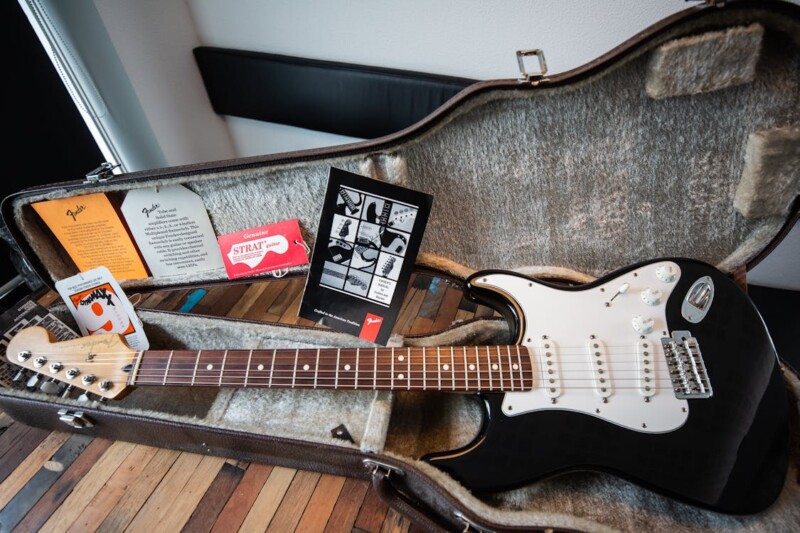Selling vintage guitars can be exciting and rewarding, especially if you are passionate about classic instruments. Knowing where to sell your gear is crucial whether you’re a seasoned musician or a collector looking to part with a cherished piece. One of the best options for selling your vintage guitar is through reputable platforms like Reverb, where listing your items is always free, and you keep a significant portion of the sale price.
Certified experts and specialized stores like True Vintage Guitar or Guitar Center can provide an appraisal and help you get the best value. These experts understand the unique qualities of vintage guitars and can guide you through preparing your gear for sale. Consignment might be the way to go if you prefer a more personalized touch, ensuring your guitar finds the right buyer while you still get a fair price.
🌟 Top Picks for Online Earnings! 🌟
Dive into our handpicked selection of the best platforms to boost your online income. Trusted by thousands, these platforms are a must-try for anyone looking to make money online.
Turn your opinions into cash with one of the most reputable online survey platforms. Explore Survey Junkie
From watching videos to shopping online, Swagbucks rewards you for everyday online activities. Dive into Swagbucks
Get rewarded for shopping, taking surveys, and more. Check Out Lifepoints
Discover a curated list of remote and flexible jobs. Find Jobs on FlexJobs
Imagine the stories your vintage guitar could tell. Wouldn’t you want it to end up in loving hands that appreciate its history and craftsmanship? The world of vintage guitars is as much about passion as it is about business, and choosing the right approach to selling your gear maximizes both financial and emotional returns.
Getting Started With Consignment

Navigating the consignment process for selling vintage guitars involves a few key steps: understanding the basics, setting up the agreement, and preparing the instruments.
Understanding Consignment Basics
Consignment is essentially a partnership between the guitar owner and the consignment shop to sell the instrument. The shop handles the marketing and selling while taking a percentage of the sale price. For vintage guitars, working with a reputable store known for its fair terms and expertise is crucial. Stores may charge various rates, usually dependent on the guitar’s value, with fees typically taken post-sale. Look for transparency in fees and services, like authentication, setup, and photography.
Setting Up Your Consignment Agreement
Before the guitar hits the showroom, the seller must sign a consignment agreement. This contract outlines crucial terms: the percentage the shop takes, how long the item will be listed, and any additional fees. Consignment shops like Carter Vintage Guitars offer clear consignment rates and detailed service descriptions. Ensure the agreement is fair and transparent. Negotiating terms where possible and clarifying all fees to avoid surprises is wise. A thorough understanding of the contract instills confidence in the seller and ensures a smooth transaction.
Preparing Your Guitars for Consignment
Preparation is key to a successful consignment. First, inspect the guitar’s condition meticulously. Ensure it’s clean, with fresh strings and minor repairs sorted. Shops like The Music Zoo won’t accept guitars that need major repairs or are missing essential parts. High-quality photos are vital, capturing the guitar’s unique aspects and condition. Write a thorough description, emphasizing significant features like the make, model, and cherished history. Proper packaging for transportation is equally important to prevent damage. Detailed prep helps attract buyers and demonstrates the seller’s commitment to offering high-quality vintage gear.
See Related: Breaking into International Markets: A Guide for Small-Scale Manufacturers
Best Practices for Consignment Forms

Well-structured and transparent forms are crucial for a successful vintage guitar consignment. The key is to ensure clarity in the contract terms and maintain transparency throughout the process.
Detailing Important Contract Clauses
Clearly outline all contract clauses to avoid misunderstandings. First, highlight the consignment fees and how they are structured. For instance, Carter Vintage Guitars charges a fee of $75 for authentication, setup, and listing services. Include any commission percentages and specify the timing of payments.
Additionally, it details the responsibilities of both parties. This includes who handles shipping costs and potential repairs. If your guitar requires minor adjustments, like string replacements, this should be clearly mentioned. Transparency in these areas builds trust and prevents future disputes.
Include a clause on withdrawal from consignment. Specify any penalties or fees if the owner prematurely withdraws the guitar from the consignment. Providing detailed information on this ensures both parties are on the same page.
Ensuring Clarity and Transparency
Make the consignment form easy to understand. Legal jargon can be intimidating, so opt for simple language. Use bold headings and bullet points to break down important sections. This helps sellers quickly grasp the necessary details.
It requires detailed descriptions and photos of the guitar. Accurate descriptions and high-quality images prevent miscommunication with potential buyers, making the listing more attractive and allowing for quicker sales.
Finally, communication should be kept open and honest. From initial contact to final sale, ensure all steps are documented and clear to both parties. This transparency reinforces a fair and trustworthy consignment process.
Encouraging sellers to ask questions and provide feedback on the form can also help refine your process and make continuous improvements.
Valuing and Pricing Vintage Guitars

Properly valuing and pricing vintage guitars involves understanding various factors influencing their worth. This section includes the essential steps to accurately appraise a vintage instrument and determine a fair selling price while considering market conditions and buyers’ interests.
Conducting a Vintage Guitar Appraisal
Appraising a vintage guitar starts with identifying the instrument’s make, model, and age. Key details such as the serial number, production year, and manufacturer are crucial. Brands like Fender, Gibson, and Martin are often more valuable.
Condition is vital. Original components and minimal wear can significantly increase a guitar’s value. Check for any modifications or repairs, as these can affect your worth. Unlike heavily altered ones, a well-preserved guitar from the 50s may fetch a high price.
Utilize resources like the “Blue Book Of Guitar Values” or the “Vintage Guitar Price Guide 2024”. These can provide insights into the current market value. Professional appraisers or trusted dealers can also offer accurate assessments.
Understanding Market Dynamics
Market dynamics play a critical role in pricing vintage guitars. Factors like rarity, demand, and economic conditions affect a guitar’s market value.
Rarity often drives up prices. Collectors highly sought-after limited editions or models with unique features. For instance, a rare 1959 Gibson Les Paul can command a premium due to scarcity.
Demand fluctuates based on trends in music and pop culture. A spike in interest in vintage Fenders could temporarily drive prices up. The economy also affects how much buyers are willing to spend. In a strong market, prices may increase due to greater disposable income.
Regularly checking platforms like Reverb and eBay helps gauge current market trends and average selling prices.
Determining the Fair Selling Price
Setting a fair selling price involves balancing the appraisal value with current market trends. Start by comparing similar listings and recently sold items. Look for guitars of the same model, year, and condition to understand the going rate.
If selling through online platforms, consider listing fees and shipping costs. Sites like Reverb or eBay can charge fees, which should be factored into the final price.
Offering room for negotiation can be beneficial. List slightly above the desired selling price to accommodate bargaining, ensuring you still achieve a satisfactory sale. Transparency about the guitar’s condition and history also builds trust with potential buyers, increasing the chances of a successful sale.
By carefully considering these aspects, sellers can achieve optimal pricing for their vintage gear.
See Related: Flipping Free Items: How to Make a Profit from Zero Investment
Customer Relations and Retention

Maintaining strong customer relations is crucial for long-term success in selling vintage guitars. By building trust with customers, ensuring their satisfaction, and cultivating repeat business, sellers can establish a loyal customer base and enhance their reputation in the market.
Building Trust with Customers
Trust forms the foundation of any customer relationship, especially in niche markets like vintage guitars. Providing transparent, accurate information about each guitar’s condition and provenance is essential. Sellers should back their claims with verifiable facts and offer detailed descriptions, photos, and sometimes video demos.
Honest communication is key. Being upfront about any flaws or repairs the instrument has undergone builds credibility. A clear return policy and warranties can also help reassure buyers that their investment is protected.
Ensuring Customer Satisfaction
Customer satisfaction goes beyond the initial sale. Prompt and courteous communication is vital. Sellers should be readily available to answer questions and provide detailed support. This can include helping customers set up their new instruments or troubleshooting issues.
Encouraging feedback and actively seeking out customer reviews can provide insights into areas for improvement. Negative feedback should be addressed swiftly and professionally. This shows a commitment to customer care and can turn a potential detractor into a promoter.
Cultivating Repeat Business
Securing repeat business requires ongoing engagement and relationship-building. Offering exclusive deals or loyalty programs for returning customers can be an effective strategy. Personalized follow-ups, such as thank-you notes or checking how customers enjoy their purchases, make buyers feel valued.
Hosting events, like vintage guitar showcases or online Q&A sessions, create a community around the brand. Maintaining contact through newsletters or social media updates keeps customers informed about new arrivals and special offers. This consistent engagement ensures that when they think of vintage guitars, they think of you.
See Related: Little-Known Ways to Make Money Online
Maximizing Profits

Selling vintage guitars can be a lucrative endeavor when approached strategically. Sellers can significantly enhance their bottom line by optimizing consignment processes, exploring diverse revenue streams, and reducing overhead and expenses.
Optimizing Consignment Processes
To boost profits via consignments, choose established shops with a solid reputation. Shops like Chicago Music Exchange or Gruhn’s Guitars offer great visibility and attract serious buyers. Negotiate the consignment fee; lower fees mean higher profit margins.
Always ensure your guitars are well-documented and appraised. Detailed listings with high-quality photos catch buyers’ attention. Adding a well-written description highlighting the guitar’s history, condition, and unique features can help justify a higher price.
Stay proactive—monitor your consignment regularly and remain open to adjusting the price based on the current market demand to maintain sales momentum.
Exploring Diverse Revenue Streams
Engaging with multiple sales channels broadens your audience and maximizes revenue. Reverb.com is great for dedicated guitarists, while eBay and other general marketplaces offer exposure to a wider array of customers.
Offer guitars at various price points to attract both novice and seasoned collectors. Additionally, consider renting out rare pieces for events or photoshoots, which can generate intermittent income without parting with valuable inventory.
Limited-edition accessories and memorabilia tied to the guitar’s history can also be sold. Promoting these items on social media can amplify reach and boost sales.
Reducing Overhead and Expenses
Budget efficiency is vital in maximizing profits. Minimize storage and maintenance costs by renting affordable climate-controlled storage spaces. Proper storage conditions help maintain guitar quality, preserving its value.
Work with shipping companies to negotiate bulk shipping discounts, easing the cost of dispatching guitars to buyers or shops. Opt for minimal yet secure packaging that still ensures the instrument’s safety.
Leverage barter deals or trade-ins to reduce the cash outlay for new acquisitions. Understand your local market dynamics and adjust your inventory according to demand trends to ensure you aren’t stuck with unsellable stock.
Leave a Reply